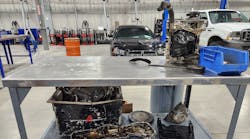Choosing the wrong power take-off (PTO) is a recipe for disaster. However, by properly selecting, installing and maintaining the PTO it should give tremendous life and value, and avoid equipment problems down the line.
The first step in the process is to decide upon the correct power take-off for your application and truck, says Jeff King, marketing manager, Chelsea Products Division of Parker. www.parker.com.
Parker, the global leader in motion and control technologies, has eight product groups which span the core motion technologies - electromechanical, hydraulic and pneumatic. The groups offer a full complement of fluid handling, filtration, sealing and shielding, climate control, process control and aerospace technologies.
“Proper selection will go a long way in establishing a lengthy, productive lifecycle with little or no vehicle downtime resulting from a mismatched PTO,” he says.
TRANSMISSION DETAILS
“First, nail down transmission details,” advises King
Essentially, a PTO serves as an extension of a vehicle’s transmission. It transmits its power to the output shaft.
“Therefore, it is imperative to begin the selection process by noting the make and model of the transmission about to receive a PTO,” he says.
More and more vocational vehicles are equipped with automatic transmissions, which have special PTO application considerations. With automatic transmissions, King says the PTO choice should include an option for pressure lubrication.
“Most automatic transmissions are not designed to concentrate the lubrication fluid near the PTO opening in quantities adequate enough to effectively lubricate the components within a PTO,” he points out. “To overcome that, Chelsea can assemble these units with special, drilled idler shafts which allow input gear bearings to be pressure-lubricated during operation.”
There may be some applications where pressure lubrication is not necessarily recommended, says King. This is the case, for example, where minimal torque requirements exist.
“But, in most vocational automatic transmission applications, a clean, cool supply of oil to the input bearings will extend PTO life.”
MANUAL TRANSMISSIONS
For those fleets using manual transmissions, pressure lubrication criteria need not be considered since the PTO is flooded with oil.
“Always take into consideration, however, that a cavity has been added onto the transmission and additional oil may be needed to bring the transmission up to its required fill level,” King says.
With manual transmissions, a broader selection of PTOs will be available.
POWERSHIFT UNITS
Most waste company fleets require a PTO that can be engaged while the vehicle is moving. These are known as powershift or hot shift PTOs.
These types of PTOs are also designed for use on automatic transmissions.
Powershift or hot shift PTOs may be shifted while the engine is running without clashing gears, even while the transmission is engaged.
UNDERSTAND CLEARANCE ISSUES
Every truck can have its challenges when mounting auxiliary equipment such as PTOs and hydraulic pumps, observes King. Depending upon the chassis, engine and transmission combinations, every truck can have a potential clearance issue.
After nailing down transmission make and model, the next item to note is the type of equipment to be driven, he says.
Since hydraulic pumps are extremely popular in the waste industry, this will serve as a good example.
Pumps, like most other PTO-driven equipment, require a fixed amount of horsepower and input speed (rpm) to produce a required flow of fluid measured in gallons per minute (gpm), explains King. Pump makers can supply these figures.
The formula to determine the horsepower required to operate a pump is:
GPM x PSI
Hydraulic HP = -------------------------------------
1,714 x Pump Efficiency
PTOs are typically rated according to torque capacity. In simplest terms, torque is that amount of force needed to make something move or run. Torque is directly related to horsepower and rpm.
There exists a basic formula, widely used, which should be used with every PTO selection, counsels King. That formula is:
HP x 5,252
PTO Torque = --------------------
RPM
By way of example, suppose a PTO will run a pump requiring 25 hp at an input speed of 1,000 rpm.
Multiplying the horsepower figure of 25, times 5,252, nets 131,300. Dividing this by the rpm figure of 1,000, the result is 131.3 foot pounds.
ROTATION AND ENGINE SPEED
Two remaining factors complete the PTO selection process, says King: rotation and percent of engine speed.
“Pumps, as well as other driven equipment, operate in one of two directions: engine or opposite engine. The direction of the device being driven determines which PTO to choose, as they, too, operate in the same two directions.”
Next, and last, consider the PTO’s percent engine speed, advises King. “This speed can increase, decrease or directly transfer the speed needed to move the equipment to be driven by the PTO. As such, the relationship is slated as a percentage.”
Assuming the same pump used in the preceding example again requires 1,000 rpm to operate. However, an engine operating speed of 1,500 rpm is desired. The PTO needed to complete this job will need to be rated at approximately two-thirds (67 percent) of engine speed.
“On the other side of the coin, if another pump requires 1,500 rpm and the desired engine operating speed is only 1,000 rpm, the PTO will have to be rated at approximately 150% of engine speed,” he says.
On new applications, the pump’s gpm capacity may often dictate which PTO to select, adds King. Distributors and manufacturers usually maintain up-to-date catalogs that cross reference both pump and PTO requirements to satisfy most any application need.
RELIABILITY IS THE RESULT
“Done step by step, the power take-off selection process is not all that complicated,” concludes King. “As a matter of fact, it may be one of the easier jobs a maintenance professional will ever have to face.”
By following the few basic dos outlined within this article, and avoiding the don’ts, a vehicle’s PTO should easily end up being just what it was intended to be: a most reliable add-on component, he says.



